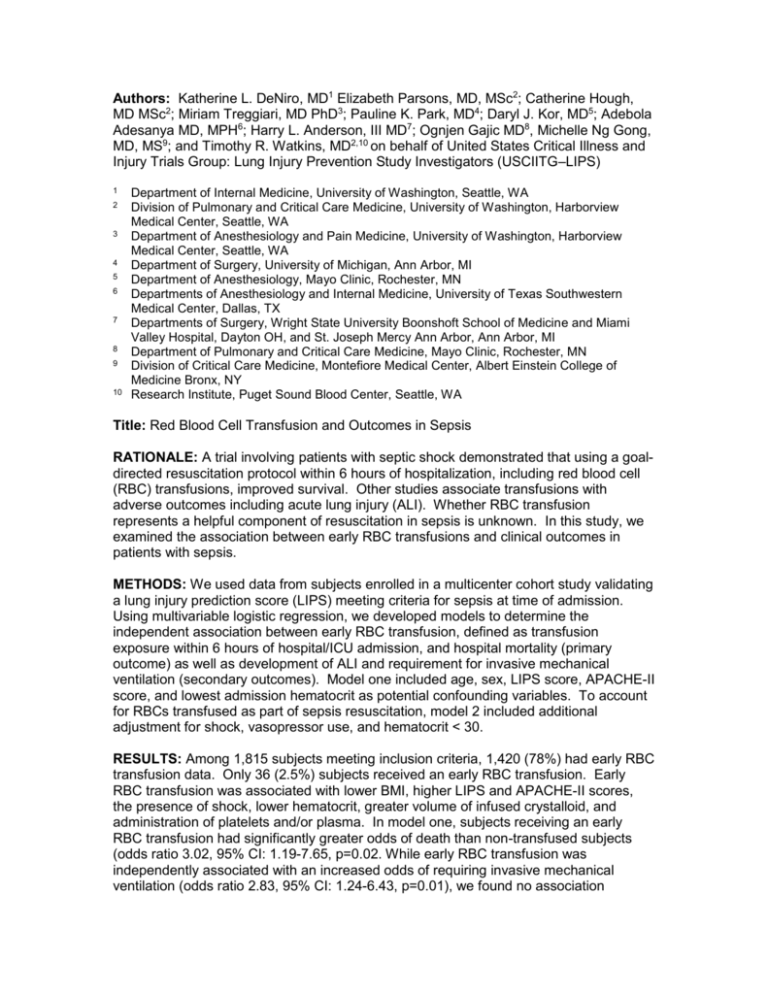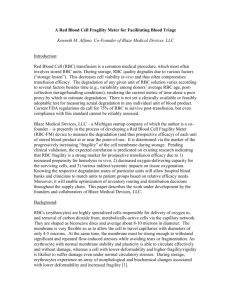Red Blood Cell Transfusion and Outcomes in Sepsis
advertisement

Authors: Katherine L. DeNiro, MD1 Elizabeth Parsons, MD, MSc2; Catherine Hough, MD MSc2; Miriam Treggiari, MD PhD3; Pauline K. Park, MD4; Daryl J. Kor, MD5; Adebola Adesanya MD, MPH6; Harry L. Anderson, III MD7; Ognjen Gajic MD8, Michelle Ng Gong, MD, MS9; and Timothy R. Watkins, MD2,10 on behalf of United States Critical Illness and Injury Trials Group: Lung Injury Prevention Study Investigators (USCIITG–LIPS) 1 2 3 4 5 6 7 8 9 10 Department of Internal Medicine, University of Washington, Seattle, WA Division of Pulmonary and Critical Care Medicine, University of Washington, Harborview Medical Center, Seattle, WA Department of Anesthesiology and Pain Medicine, University of Washington, Harborview Medical Center, Seattle, WA Department of Surgery, University of Michigan, Ann Arbor, MI Department of Anesthesiology, Mayo Clinic, Rochester, MN Departments of Anesthesiology and Internal Medicine, University of Texas Southwestern Medical Center, Dallas, TX Departments of Surgery, Wright State University Boonshoft School of Medicine and Miami Valley Hospital, Dayton OH, and St. Joseph Mercy Ann Arbor, Ann Arbor, MI Department of Pulmonary and Critical Care Medicine, Mayo Clinic, Rochester, MN Division of Critical Care Medicine, Montefiore Medical Center, Albert Einstein College of Medicine Bronx, NY Research Institute, Puget Sound Blood Center, Seattle, WA Title: Red Blood Cell Transfusion and Outcomes in Sepsis RATIONALE: A trial involving patients with septic shock demonstrated that using a goaldirected resuscitation protocol within 6 hours of hospitalization, including red blood cell (RBC) transfusions, improved survival. Other studies associate transfusions with adverse outcomes including acute lung injury (ALI). Whether RBC transfusion represents a helpful component of resuscitation in sepsis is unknown. In this study, we examined the association between early RBC transfusions and clinical outcomes in patients with sepsis. METHODS: We used data from subjects enrolled in a multicenter cohort study validating a lung injury prediction score (LIPS) meeting criteria for sepsis at time of admission. Using multivariable logistic regression, we developed models to determine the independent association between early RBC transfusion, defined as transfusion exposure within 6 hours of hospital/ICU admission, and hospital mortality (primary outcome) as well as development of ALI and requirement for invasive mechanical ventilation (secondary outcomes). Model one included age, sex, LIPS score, APACHE-II score, and lowest admission hematocrit as potential confounding variables. To account for RBCs transfused as part of sepsis resuscitation, model 2 included additional adjustment for shock, vasopressor use, and hematocrit < 30. RESULTS: Among 1,815 subjects meeting inclusion criteria, 1,420 (78%) had early RBC transfusion data. Only 36 (2.5%) subjects received an early RBC transfusion. Early RBC transfusion was associated with lower BMI, higher LIPS and APACHE-II scores, the presence of shock, lower hematocrit, greater volume of infused crystalloid, and administration of platelets and/or plasma. In model one, subjects receiving an early RBC transfusion had significantly greater odds of death than non-transfused subjects (odds ratio 3.02, 95% CI: 1.19-7.65, p=0.02. While early RBC transfusion was independently associated with an increased odds of requiring invasive mechanical ventilation (odds ratio 2.83, 95% CI: 1.24-6.43, p=0.01), we found no association between early RBC transfusion and ALI development (odds ratio 0.82, 95% CI: 0.252.64, p=0.74). In model two, we found death and invasive mechanical ventilation were significantly associated with early RBC transfusion. In the second model, there still was no significant association with ALI (Table 1). CONCLUSIONS: Early RBC transfusions were rarely administered in a broad cohort of patients with sepsis. We found significant associations between early RBC transfusion and both mortality and requirement for invasive mechanical ventilation; however, early RBC transfusion was not associated with ALI development. Further research is required to confirm these findings and to examine potential mechanisms. Table 1. Outcomes with early RBC transfusion among subjects with sepsis (N=1420) Model 1 (N=1400) Odds Ratio for Death In ICU Over Hospitalization Odds Ratio for Acute Lung Injury Odds Ratio for Ventilator Support Invasive Noninvasive a Adjusted Model 2 (N=1389) Adjusted Estimate a (95% CI) P value Adjusted Estimate b (95% CI) P value 2.12 (0.77, 5.83) 3.02 (1.19, 7.65) 0.143 0.020 2.22 (0.82, 6.04) 2.76 (1.11, 6.85) 0.116 0.028 0.82 (0.25, 2.64) 0.742 0.87 (0.27, 2.76) 0.815 2.83 (1.24, 6.43) 0.49 (0.16, 1.48) 0.013 0.208 2.69 (1.17, 6.17) 0.58 (0.19, 1.74) 0.020 0.334 for age, sex, APACHE II score, LIPS score, and lowest admission hematocrit (continuous). b Adjusted for age, sex, APACHE II score, LIPS score, hematocrit < 30 (yes/no), and vasopressor infusion in the first 6 hours.









